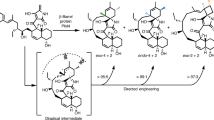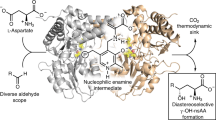Abstract
For many important reactions catalyzed in chemical laboratories, the corresponding enzymes are missing, representing a restriction in biocatalysis. Although nature provides highly developed machineries appropriate to catalyze such reactions, their potential is often ignored. This also applies to Brønsted acid catalysis, a powerful method to promote a myriad of chemical transformations. Here, we report on the unique protonation machinery of a squalene hopene cyclase (SHC). Active site engineering of this highly evolvable enzyme yielded a platform for enzymatic Brønsted acid catalysis in water. This is illustrated by activation of different functional groups (alkenes, epoxides and carbonyls), enabling the highly stereoselective syntheses of various cyclohexanoids while uncoupling SHC from polycyclization chemistry. This work highlights the potential of systematic investigation on nature's catalytic machineries to generate unique catalysts.
This is a preview of subscription content, access via your institution
Access options
Subscribe to this journal
Receive 12 print issues and online access
$259.00 per year
only $21.58 per issue
Buy this article
- Purchase on Springer Link
- Instant access to full article PDF
Prices may be subject to local taxes which are calculated during checkout



Similar content being viewed by others
Accession codes
References
Turner, N.J. & Reilly, E.O. Biocatalytic retrosynthesis. Nat. Chem. Biol. 9, 285–288 (2013).
Nestl, B.M., Hammer, S.C., Nebel, B.A. & Hauer, B. New generation of biocatalysts for organic synthesis. Angew. Chem. Int. Ed. Engl. 53, 3070–3095 (2014).
Bornscheuer, U.T. et al. Engineering the third wave of biocatalysis. Nature 485, 185–194 (2012).
Siegel, J.B. et al. Computational design of an enzyme catalyst for a stereoselective bimolecular Diels-Alder reaction. Science 329, 309–313 (2010).
Hyster, T.K., Knörr, L., Ward, T.R. & Rovis, T. Biotinylated Rh(iii) complexes in engineered streptavidin for accelerated asymmetric C-H activation. Science 338, 500–503 (2012).
Bornscheuer, U.T. & Kazlauskas, R.J. Catalytic promiscuity in biocatalysis: using old enzymes to form new bonds and follow new pathways. Angew. Chem. Int. Ed. Engl. 43, 6032–6040 (2004).
Breslow, R. Biomimetic chemistry: biology as an inspiration. J. Biol. Chem. 284, 1337–1342 (2009).
Knowles, R.R. & Jacobsen, E.N. Attractive noncovalent interactions in asymmetric catalysis: links between enzymes and small molecule catalysts. Proc. Natl. Acad. Sci. USA 107, 20678–20685 (2010).
Coelho, P.S., Brustad, E.M., Kannan, A. & Arnold, F.H. Olefin cyclopropanation via carbene transfer catalyzed by engineered cytochrome P450 enzymes. Science 339, 307–310 (2013).
McIntosh, J.A. et al. Enantioselective intramolecular C-H amination catalyzed by engineered cytochrome P450 enzymes in vitro and in vivo. Angew. Chem. Int. Ed. Engl. 52, 9309–9312 (2013).
Wang, Z.J., Peck, N.E., Renata, H. & Arnold, F.H. Cytochrome P450-catalyzed insertion of carbenoids into N-H bonds. Chem. Sci. 5, 598–601 (2014).
Akiyama, T. Stronger Brønsted acids. Chem. Rev. 107, 5744–5758 (2007).
Terada, M. Binaphthol-derived phosphoric acid as a versatile catalyst for enantioselective carbon-carbon bond forming reactions. Chem. Commun. (Camb.) 4097–4112 (2008).
Kampen, D., Reisinger, C.M. & List, B. Chiral Brønsted acids for asymmetric organocatalysis. Top. Curr. Chem. 291, 395–456 (2010).
Rueping, M., Nachtsheim, B.J., Ieawsuwan, W. & Atodiresei, I. Modulating the acidity: highly acidic Brønsted acids in asymmetric catalysis. Angew. Chem. Int. Ed. Engl. 50, 6706–6720 (2011).
Cheon, C.H. & Yamamoto, H. Super Brønsted acid catalysis. Chem. Commun. (Camb.) 47, 3043–3056 (2011).
Jiang, J., He, X. & Cane, D.E. Biosynthesis of the earthy odorant geosmin by a bifunctional Streptomyces coelicolor enzyme. Nat. Chem. Biol. 3, 711–715 (2007).
Kim, H.J., Ruszczycky, M.W. & Liu, H.-W. Current developments and challenges in the search for a naturally selected Diels-Alderase. Curr. Opin. Chem. Biol. 16, 124–131 (2012).
Stecher, H. et al. Biocatalytic Friedel-Crafts alkylation using non-natural cofactors. Angew. Chem. Int. Ed. Engl. 48, 9546–9548 (2009).
Metzger, U. et al. The structure of dimethylallyl tryptophan synthase reveals a common architecture of aromatic prenyltransferases in fungi and bacteria. Proc. Natl. Acad. Sci. USA 106, 14309–14314 (2009).
Schowen, K.B., Limbach, H.H., Denisov, G.S. & Schowen, R.L. Hydrogen bonds and proton transfer in general-catalytic transition-state stabilization in enzyme catalysis. Biochim. Biophys. Acta 1458, 43–62 (2000).
Hammer, S.C., Syrén, P.-O., Seitz, M., Nestl, B.M. & Hauer, B. Squalene hopene cyclases: highly promiscuous and evolvable catalysts for stereoselective C–C and C–X bond formation. Curr. Opin. Chem. Biol. 17, 293–300 (2013).
Wendt, K.U., Schulz, G.E., Corey, E.J. & Liu, D.R. Enzyme mechanisms for polycyclic triterpene formation. Angew. Chem. Int. Ed. Engl. 39, 2812–2833 (2000).
Wendt, K.U. Enzyme mechanisms for triterpene cyclization: new pieces of the puzzle. Angew. Chem. Int. Ed. Engl. 44, 3966–3971 (2005).
Gao, Y., Honzatko, R.B. & Peters, R.J. Terpenoid synthase structures: a so far incomplete view of complex catalysis. Nat. Prod. Rep. 29, 1153–1175 (2012).
Syrén, P.-O., Hammer, S.C., Claasen, B. & Hauer, B. Entropy is key to the formation of pentacyclic terpenoids by enzyme-catalyzed polycyclization. Angew. Chem. Int. Ed. Engl. 53, 4845–4849 (2014).
Gandour, R.D. On the importance of orientation in general base catalysis by carboxylate. Bioorg. Chem. 10, 169–176 (1981).
Yonemura, Y., Ohyama, T. & Hoshino, T. Chemo-enzymatic syntheses of drimane-type sesquiterpenes and the fundamental core of hongoquercin meroterpenoid by recombinant squalene-hopene cyclase. Org. Biomol. Chem. 10, 440–446 (2012).
Hammer, S.C., Dominicus, J.M., Syrén, P.-O., Nestl, B.M. & Hauer, B. Stereoselective Friedel-Crafts alkylation catalyzed by squalene hopene cyclases. Tetrahedron 68, 7624–7629 (2012).
Seitz, M. et al. Synthesis of heterocyclic terpenoids by promiscuous squalene-hopene cyclases. ChemBioChem 14, 436–439 (2013).
Breuer, M., Hörster, A. & Hauer, B. Biocatalytic production of Ambroxan. WO Patent 2010/139719 A2 (2010).
Neumann, S. & Simon, H. Purification, partial characterization and substrate specificity of a squalene cyclase from Bacillus acidocaldarius. Biol. Chem. Hoppe Seyler 367, 723–729 (1986).
Hoshino, T., Kumai, Y., Kudo, I., Nakano, S. & Ohashi, S. Enzymatic cyclization reactions of geraniol, farnesol and geranylgeraniol, and those of truncated squalene analogs having C20 and C25 by recombinant squalene cyclase. Org. Biomol. Chem. 2, 2650–2657 (2004).
Racolta, S., Juhl, P.B., Sirim, D. & Pleiss, J. The triterpene cyclase protein family: A systematic analysis. Proteins 80, 2009–2019 (2012).
Siedenburg, G. et al. Activation-independent cyclization of monoterpenoids. Appl. Environ. Microbiol. 78, 1055–1062 (2012).
Siedenburg, G., Breuer, M. & Jendrossek, D. Prokaryotic squalene-hopene cyclases can be converted to citronellal cyclases by single amino acid exchange. Appl. Microbiol. Biotechnol. 97, 1571–1580 (2013).
Seitz, M. et al. Substrate specificity of a novel squalene-hopene cyclase from Zymomonas mobilis. J. Mol. Catal., B Enzym. 84, 72–77 (2012).
Reinert, D.J., Balliano, G. & Schulz, G.E. Conversion of squalene to the pentacarbocyclic hopene. Chem. Biol. 11, 121–126 (2004).
Lenardão, E.J., Botteselle, G.V., de Azambuja, F., Perin, G. & Jacob, R.G. Citronellal as key compound in organic synthesis. Tetrahedron 63, 6671–6712 (2007).
Mäki-Arvela, P. et al. Cyclization of citronellal over zeolites and mesoporous materials for production of isopulegol. J. Catal. 225, 155–169 (2004).
Turner, N.J. Directed evolution drives the next generation of biocatalysts. Nat. Chem. Biol. 5, 567–573 (2009).
Wendt, K.U., Poralla, K. & Schulz, G.E. Structure and function of a squalene cyclase. Science 277, 1811–1815 (1997).
Savile, C.K. et al. Biocatalytic asymmetric synthesis of chiral amines from ketones applied to sitagliptin manufacture. Science 329, 305–309 (2010).
Sandström, A.G., Wikmark, Y., Engström, K., Nyhlén, J. & Bäckvall, J.-E. Combinatorial reshaping of the Candida antarctica lipase A substrate pocket for enantioselectivity using an extremely condensed library. Proc. Natl. Acad. Sci. USA 109, 78–83 (2012).
Jung, S.T., Lauchli, R. & Arnold, F.H. Cytochrome P450: taming a wild type enzyme. Curr. Opin. Biotechnol. 22, 809–817 (2011).
Babtie, A., Tokuriki, N. & Hollfelder, F. What makes an enzyme promiscuous? Curr. Opin. Chem. Biol. 14, 200–207 (2010).
Tokuriki, N. & Tawfik, D.S. Protein dynamism and evolvability. Science 324, 203–207 (2009).
Merlini, V., Luparia, M., Porta, A., Zanoni, G. & Vidari, G. Biomimetic cyclization of geraniol derivatives, a useful tool in the total synthesis of bioactive monocyclic terpenoids. Nat. Prod. Commun. 6, 465–476 (2011).
Brunoldi, E., Luparia, M., Porta, A., Zanoni, G. & Vidari, G. Biomimetic cyclizations of functionalized isoprenoid polyenes: a cornucopia of synthetic opportunities. Curr. Org. Chem. 10, 2259–2282 (2006).
Rueping, M. & Theissmann, T. Asymmetric Brønsted acid catalysis in aqueous solution. Chem. Sci. 1, 473–476 (2010).
Surendra, K. & Corey, E.J. Rapid and enantioselective synthetic approaches to germanicol and other pentacyclic triterpenes. J. Am. Chem. Soc. 130, 8865–8869 (2008).
Tsangarakis, C., Raptis, C., Arkoudis, E. & Stratakis, M. Zeolite NaY-promoted monocyclization of epoxy polyene terpenes: a unique route for the direct synthesis of incompletely cyclized naturally occurring terpenols. Adv. Synth. Catal. 350, 1587–1600 (2008).
Beszant, S., Giannini, E., Zanoni, G. & Vidari, G. Enantioselective synthesis of both enantiomers of γ-ionone, γ-damascone, karahana lactone and karahana ether. Tetrahedron Asymmetry 13, 1245–1255 (2002).
Studier, F.W. Protein production by auto-induction in high-density shaking cultures. Protein Expr. Purif. 41, 207–234 (2005).
Acknowledgements
We gratefully acknowledge funding by the European Union's Seventh Framework Programme FP7/2007–2013 under grant agreement no. 289646 as well as a Kekulé scholarship by the Fonds der Chemischen Industrie (to SCH, grant number K 187/01). We thank P.-O. Syrén (KTH Royal Institute of Technology, Stockholm) for stimulating discussions, M. Breuer (BASF SE, Ludwigshafen) for the AacSHC gene, C. Geinitz (University of Stuttgart) for providing the mutants at position F365 and E. Kervio (University of Stuttgart) for help with measuring specific rotations of the products.
Author information
Authors and Affiliations
Contributions
S.C.H., B.M.N. and B.H. designed the research. S.C.H. and A.M. designed and performed the experiments. J.M.D. synthesized the racemic standards. All authors contributed to the interpretation of the results and the preparation of the manuscript.
Corresponding author
Ethics declarations
Competing interests
The authors declare no competing financial interests.
Supplementary information
Supplementary Text and Figures
Supplementary Notes, Supplementary Results, Supplementary Figures 1–24 and Supplementary Table 1. (PDF 5011 kb)
Rights and permissions
About this article
Cite this article
Hammer, S., Marjanovic, A., Dominicus, J. et al. Squalene hopene cyclases are protonases for stereoselective Brønsted acid catalysis. Nat Chem Biol 11, 121–126 (2015). https://doi.org/10.1038/nchembio.1719
Received:
Accepted:
Published:
Issue Date:
DOI: https://doi.org/10.1038/nchembio.1719



